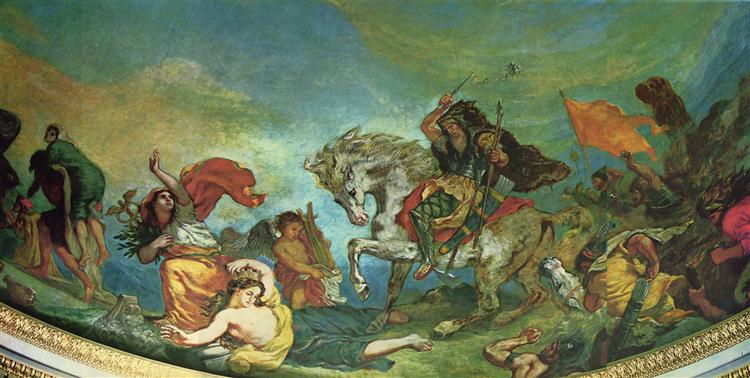Description
Eugène Delacroix's "Attila and his Hordes Invade Italy and the Arts", painted in 1847, is a powerful example of Romanticism, a movement that exalted emotion, individuality, and the sublime in contrast to the stricter norms of Neoclassicism. In this painting, Delacroix captures a dramatic and tumultuous moment that symbolizes the confrontation between barbarism and civilization, depicting the invasion of Attila, King of the Huns, as a metaphor for the threat to culture and art.
The composition of the work is intensely dynamic, with energetic figures seemingly moving in a whirlwind of chaos. Attila, the famous conqueror, appears at the centre of the scene, mounted on his horse, which rears in a pose of agitation. His figure is surrounded by a multitude of troops, who are in turn spread out across the canvas, creating a sense of movement and disorder. Delacroix uses diagonal lines to guide the viewer’s eye around the painting, from the central figure outwards to the sides, which are filled with action and excitement. This rhythmic structure prevents the composition from feeling static, a key feature of the work of Delacroix, who was known for his ability to convey emotion through compositional structure.
The intense and passionate colours used in the painting are another aspect to highlight. Delacroix employs a rich and varied palette, where reds, browns and golds predominate in the clothing and landscape, contrasting with the darker tones that can be seen in the shadows and on the horses. This use of colour not only helps to emphasise the drama of the scene, but also adds an almost symbolic dimension, suggesting the violence and destruction associated with Attila's invasion. The contrast of light and shadow adds emotional depth, illuminating the figures in such a way that they seem to almost come to life.
The inclusion of the characters, though not all clearly identifiable, reinforces the visual narrative of the work. Delacroix manages to capture not only the grandeur of Attila, but also the desperation and fear felt by those being invaded, thereby conveying a strong sense of empathy. The facial expressions of the figures in the background reveal a mix of terror and resistance, a testament to the emotional impact the invasion has on those in its path.
Finally, it is interesting to consider the historical and cultural context in which Delacroix created this work. In 1847, France was experiencing a number of political and social tensions that resonated with the themes of resistance to oppression and the quest for freedom and art. This painting can be seen, within this context, as a reflection on the dangers facing cultures and values in times of upheaval. As such, it is not only a testament to Delacroix’s technical virtuosity, but also a powerful statement about the role of art in history – a reminder that, like Attila’s hordes, the forces of destruction may threaten civilisation, but art is also a means of resistance and an expression of the human experience.
In conclusion, Attila and his Hordes Invade Italy and the Arts is a work in which Delacroix combines technical mastery, emotion and a profound reflection on the human condition. The painting not only stands out in the panorama of its time, but continues to resonate with contemporary viewers, reminding us of the eternal conflict between art and barbarism.
KUADROS ©, a famous painting on your wall.
Hand-made oil painting reproductions, with the quality of professional artists and the distinctive seal of KUADROS ©.
Painting reproduction service with satisfaction guarantee. If you are not completely satisfied with the replica of your painting, we will refund 100% of your money.

